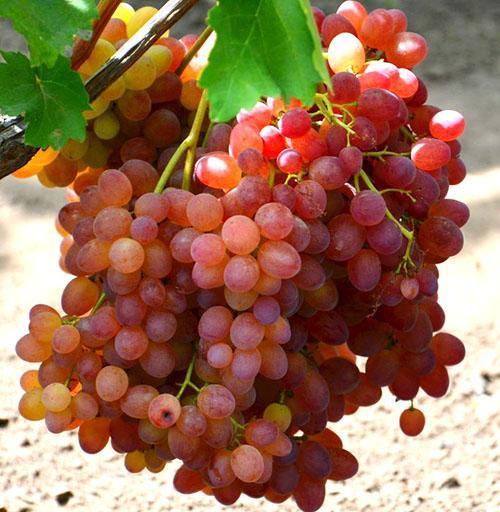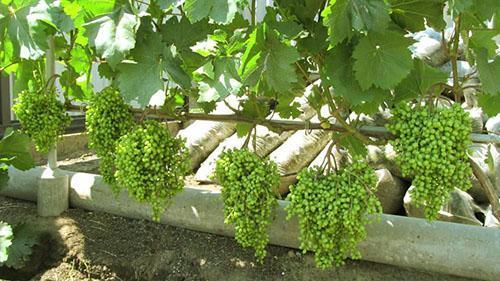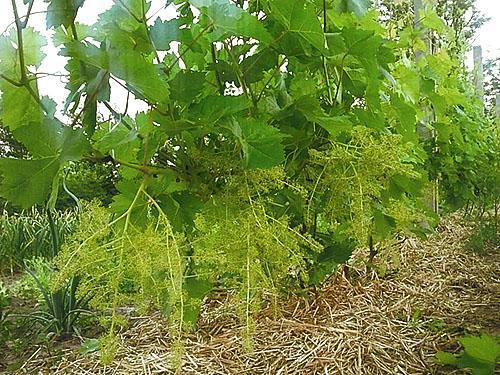Description and photo of the grape variety Veles
 For the first time, seedlings of the hybrid form of Veles grapes became available to lovers of this culture in 2009. Photo of the variety and description grapes Veles, obtained by the famous Ukrainian breeder-enthusiast V.V. Zagorulko, aroused serious interest from winegrowers in Ukraine, southern Russia and even Belarus.
For the first time, seedlings of the hybrid form of Veles grapes became available to lovers of this culture in 2009. Photo of the variety and description grapes Veles, obtained by the famous Ukrainian breeder-enthusiast V.V. Zagorulko, aroused serious interest from winegrowers in Ukraine, southern Russia and even Belarus.
Characteristics of the Velez grape and its description
The hybrid is distinguished by a very high growth rate of the bushes; under favorable weather conditions, the shoots ripen well.
The number of eyes per bush should not exceed 35. Taking this into account, it is necessary, as in the video, to form a grape bush, while leaving on the shoots 2–4 powerful volumetric inflorescences consisting of small yellow-green bisexual flowers. Such a flower structure of a promising hybrid facilitates pollination and allows very large clusters to be tied, up to 30 cm long and about 20 cm wide. The bunches are voluminous, very branched, of medium density or loose, in the form of a wide cone.
 According to the description and photo of the Veles grape variety, ripe bunches weigh from 600 to 2000 grams, although growers who have already managed to grow bushes on their plots and get the first harvests demonstrate brushes weighing about 3 kg. The hybrid, which belongs to the third class of seedlessness, is distinguished by high consumer appeal and taste.
According to the description and photo of the Veles grape variety, ripe bunches weigh from 600 to 2000 grams, although growers who have already managed to grow bushes on their plots and get the first harvests demonstrate brushes weighing about 3 kg. The hybrid, which belongs to the third class of seedlessness, is distinguished by high consumer appeal and taste.
As the berries ripen, they acquire a spectacular pink hue and reach a weight of 5 grams.
Dense, jelly, translucent pulp has a decent taste with a pronounced nutmeg shade. According to experts, the taste of the new hybrid deserves higher ratings than the berries of another famous variety - Radiant raisin. No wonder the novelty of the selection already in 2010, precisely during tasting, was awarded two highest awards at the Crimean competition "Golden bunch of grapes".
The berries are covered with a medium-thick skin, which is invisible when used with grapes. In 20% of berries, rudiments of seeds do not interfere with the perception of taste.
Features of grape growing technology
 If the technology of growing grapes provides for the treatment of brushes with gibberellin, the oval berries enlarge and somewhat lengthen, while the number of completely seedless fruits increases sharply. The existing experience of growing grapes outdoors shows that high humidity can cause the development of gray rot on the cracking of ripening berries.
If the technology of growing grapes provides for the treatment of brushes with gibberellin, the oval berries enlarge and somewhat lengthen, while the number of completely seedless fruits increases sharply. The existing experience of growing grapes outdoors shows that high humidity can cause the development of gray rot on the cracking of ripening berries.
Brushes with ripe berries are well stored and transported. Shoots carry the weight of the bunches well. In dry weather, the brushes can be stored on the vine for up to one and a half months, completely preserving all the taste and juiciness. According to winegrowers, even a slight degree of raisin is not reflected in the bouquet of grapes, but only enhances the muscat notes.
 According to the photo of the variety and the description of the grapes, Veles is prone to the formation of stepchildren.In the southern regions, on such an increase, an additional second crop is obtained, which ripens at the end of September or in October. In the middle lane, where there is less time for the ripening of the shoots, it is better to remove the stepsons.
According to the photo of the variety and the description of the grapes, Veles is prone to the formation of stepchildren.In the southern regions, on such an increase, an additional second crop is obtained, which ripens at the end of September or in October. In the middle lane, where there is less time for the ripening of the shoots, it is better to remove the stepsons.
Reproduction and care of Veles grapes
 For propagation of grapes, cuttings harvested in the fall are used. Saplings can be either with their own root system or grafted. The survival rate in new plantings is high, fruiting in favorable conditions can begin as early as the second year, but for better development of the bush it is more expedient to remove the inflorescences that form. In care, the hybrid form will not cause much trouble. The Veles grape has an average, at the level of 3.5 points, resistance to downy mildew and powdery mildew. When carrying out preventive treatments of this culture with means of protection, the risk of contracting these diseases becomes minimal.
For propagation of grapes, cuttings harvested in the fall are used. Saplings can be either with their own root system or grafted. The survival rate in new plantings is high, fruiting in favorable conditions can begin as early as the second year, but for better development of the bush it is more expedient to remove the inflorescences that form. In care, the hybrid form will not cause much trouble. The Veles grape has an average, at the level of 3.5 points, resistance to downy mildew and powdery mildew. When carrying out preventive treatments of this culture with means of protection, the risk of contracting these diseases becomes minimal.
The winter hardiness of the variety that can withstand frosts down to –21 ° C is insufficient to grow grapes in the open field without additional shelter in the middle lane. In the southern regions, Veles winters well, and even if some shoots are damaged from the cold, the bushes quickly recover during the season.
It is possible to improve the ripening of shoots and increase the quality of the crop using spring pruning and normalization.
 At the same time, 6–8 eyes are left on the vine per shoot, and under favorable climatic conditions on strong bushes, the load is increased. As you can see in the photo and from the description, Veles grapes are characterized by high yields. The bushes annually form inflorescences and produce a large number of ovaries. The first main crop is harvested in August, and when using stepchildren, the second wave of berries ripens in mid-autumn.
At the same time, 6–8 eyes are left on the vine per shoot, and under favorable climatic conditions on strong bushes, the load is increased. As you can see in the photo and from the description, Veles grapes are characterized by high yields. The bushes annually form inflorescences and produce a large number of ovaries. The first main crop is harvested in August, and when using stepchildren, the second wave of berries ripens in mid-autumn.
Such a characteristic feature of the culture makes it possible to speak of the suitability of the hybrid for cultivation in a wide variety of climatic zones, from central Russia to the Kuban and Crimea. Subject to the technology of growing grapes, Veles will regularly supply the grower with large, excellent quality berries.
